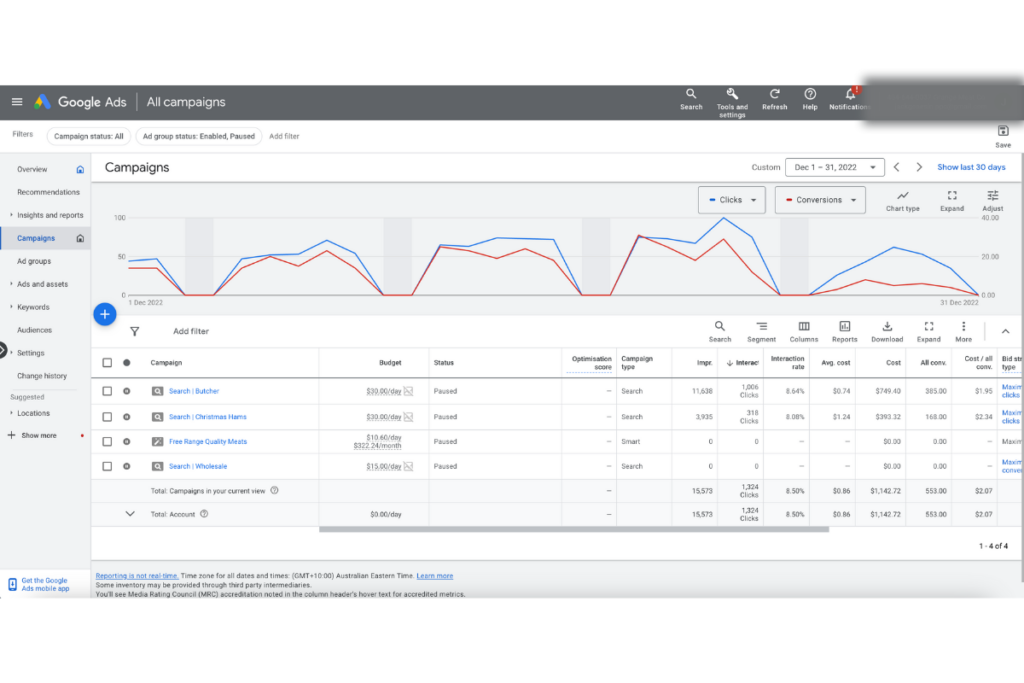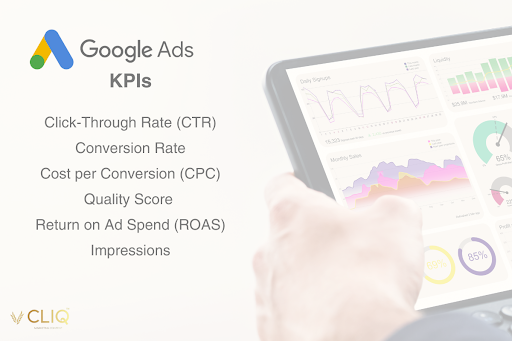Google Ads, an ever-evolving platform, offers businesses across Australia and beyond a chance to reach their target audience with precision and efficiency. However, the true effectiveness of these campaigns isn’t just in their reach; it’s in their ability to be measured, analysed, and optimised.
In this article, we’ll delve into the vital aspects of Google Ads measurement and performance, exploring how they intertwine to drive successful outcomes. We’ll discuss the importance of key metrics, the nuances of performance analysis, and share insights on leveraging data for strategic decision-making. Whether you’re a small business owner in Sydney or a marketing manager in Melbourne, understanding these concepts is crucial for maximising your Google Ads investment. Let’s jump right in!
How Do You Measure Google Ads Performance?
Wondering how to measure Google Ads performance? The truth is, it is a multifaceted process that involves tracking various metrics and analysing data to assess the effectiveness of your advertising campaigns. Here are the key steps and considerations for measuring Google Ads performance:
Set Clear Objectives
Before measuring performance, clearly define what you want to achieve with your Google Ads campaign. Goals could range from increasing website traffic, generating leads, boosting sales, or enhancing brand awareness. Then, based on your goals, identify Key Performance Indicators (KPIs) that will help you measure success. For example, if your goal is lead generation, your KPI might be the number of completed forms or sign-ups.
Utilise Google Ads and Analytics Tools
Use Google Ads’ built-in metrics to track performance. Key metrics include Click-Through Rate (CTR), Cost Per Click (CPC), Conversion Rate, Quality Score, and Return on Ad Spend (ROAS). Linking Google Ads with Google Analytics provides a deeper insight into user behaviour post-click. It allows you to track metrics like bounce rate, average session duration, and pages per session.
Analyse Performance Metrics
CTR and CPC show how often your ads are clicked and at what cost. A high CTR indicates effective ad copy and targeting, while a lower CPC means you’re getting more value for your budget. Conversion rates indicate the percentage of clicks that result in the desired action (like a sale or sign-up). It’s crucial for understanding the effectiveness of your ads in driving outcomes. Last but not least is Quality Score, a composite measure based on your ad relevance, landing page quality, and CTR. A higher score can lead to lower costs and better ad positions.
Monitor Conversion Tracking
Implement conversion tracking in Google Ads to measure actions like purchases, form submissions, and phone calls. Using conversion attribution, understand which ads, keywords, or campaigns are driving conversions. This helps in reallocating budget to the most effective areas.
Reports and Analysis
Regularly create and review reports to track progress over time. Look for trends, patterns, and areas of improvement. Continuously test different elements of your ads (like headlines, descriptions, and landing pages) to see what works best and refine your approach.
Return on Ad Spend (ROAS)
This metric helps you understand the financial return of your ad spend. It’s calculated by dividing the revenue generated from ads by the total ad spend.
Adapt and Optimise
Use the data and insights gathered to optimise your campaigns. This could involve adjusting bids, refining targeting, or tweaking ad creatives.
What is Google Ads Measurement?
How do you go about measuring Adwords? Google Ads measurement is a comprehensive process that encompasses the collection, analysis, and interpretation of data from Google Ads campaigns. This process is vital for assessing the effectiveness of these campaigns in achieving marketing objectives such as increased website traffic, lead generation, or sales.
Central to this process is the tracking of various metrics and Key Performance Indicators (KPIs) like Click-Through Rate (CTR), Conversion Rate, Cost Per Conversion (CPC), and Return on Ad Spend (ROAS). These indicators are instrumental in evaluating how well the campaigns align with set goals.
A critical aspect of Google Ads measurement is the integration with tools like Google Analytics. This integration provides deeper insights into user behaviour post-click, such as the duration of website visits, pages visited, and actions taken, offering a fuller picture of the customer journey from the initial ad interaction to post-conversion engagement. Real-time monitoring and historical data analysis are key techniques used, allowing advertisers to make immediate adjustments for optimisation and to identify trends and areas for improvement over time.
Advanced tracking methods, such as remarketing lists and custom audiences based on specific user behaviours, enhance the targeting and effectiveness of campaigns. Moreover, understanding and choosing the right attribution models—whether it’s last-click, first-click, or data-driven—plays a crucial role in accurately assigning credit for conversions to various touchpoints in the customer journey.
The significance of Google Ads measurement lies in its ability to drive data-driven decision-making. Insights gained from this process guide strategic decisions related to budget allocation, bidding strategies, and creative adjustments, leading to continuous improvement of campaigns.
This ongoing optimisation process is essential for maintaining a competitive edge, as it allows businesses to adapt their strategies quickly based on performance data, thereby achieving better ROI and efficiently meeting their marketing objectives. In summary, Google Ads measurement is not just about tracking data but using that data to inform and refine every aspect of digital advertising strategy.

What is the Main KPI in Google Ads?
In Google Ads, the main Key Performance Indicator (KPI) often varies depending on the specific goals and objectives of the campaign. However, there are a few KPIs commonly regarded as crucial for most Google Ads campaigns:
Click-Through Rate (CTR): CTR is a fundamental KPI in Google Ads and is calculated by dividing the number of clicks your ad receives by the number of times your ad is shown (impressions). A high CTR generally indicates that your ads are relevant and appealing to your target audience.
Conversion Rate: This measures the percentage of users who click on your ad and then take a desired action on your website, such as making a purchase, signing up for a newsletter, or filling out a contact form. A high conversion rate suggests that your ads are effective in driving meaningful actions.
Cost per Conversion (CPC): This KPI helps in evaluating the cost-effectiveness of your Google Ads campaign. It’s calculated by dividing the total cost of your clicks by the number of conversions. This metric is crucial for understanding the return on investment (ROI) of your ad spend.
Quality Score: While not a direct performance metric, the Quality Score is vital in Google Ads. It’s a rating of the quality and relevance of both your keywords and PPC ads. A high Quality Score can lead to lower costs and better ad placements.
Return on Ad Spend (ROAS): ROAS is a crucial KPI for campaigns where the primary goal is direct sales. It measures the return you’re getting for every dollar spent on your ads. A high ROAS indicates a profitable campaign.
Impressions and Impression Share: These metrics are important for brand awareness campaigns. Impressions count how often your ad has been shown, while impression share represents the percentage of times your ad was shown out of the total available impressions in the market for your chosen keywords.
Ultimately, the main KPI in Google Ads should align with what you want to achieve with your campaign, whether it’s driving sales, generating leads, increasing website traffic, or boosting brand awareness.

Your Next Steps to Measuring the Metrics that Matter in Google
Mastering Google Ads measurement and performance is a pivotal aspect of digital marketing success. The journey begins with setting clear objectives for your campaigns, identifying relevant KPIs, and then diving deep into the data provided by Google Ads and Analytics. By focusing on key metrics such as Click-Through Rate (CTR), Conversion Rate, and Cost Per Conversion (CPC), marketers can gain invaluable insights into the effectiveness of their campaigns.
CTR serves as a primary gauge of how compelling and relevant your ads are to your target audience, highlighting the quality of your ad creatives and targeting strategies. Meanwhile, Conversion Rate cuts to the heart of campaign efficacy, revealing whether your ads are just attracting eyeballs or actually prompting meaningful actions. Cost per Conversion further extends this analysis, offering a clear view of the financial efficiency of your ads, a crucial factor in ensuring sustainable campaign strategies.
The integration of Google Ads with tools like Google Analytics enriches this data, allowing a deeper understanding of user behaviour and the customer journey. This integration is critical for tailoring campaigns to the nuanced needs and behaviours of your audience. Moreover, the use of advanced tracking methods, such as remarketing lists and custom audiences, and the careful selection of attribution models, enable marketers to fine-tune their strategies for maximum impact.
Ultimately, the continuous process of measuring, analysing, and optimising Google Ads campaigns is what sets successful digital marketing efforts apart. Regular reporting and analysis, coupled with A/B testing and staying abreast of the latest trends, are essential practices. This relentless pursuit of improvement, grounded in data and driven by clearly defined metrics, is the key to unlocking the full potential of Google Ads.
But even just knowing what performance metrics to use in Google Ads isn’t enough to move the needle on your Australian campaigns. Measuring Adwords is part art and part science, and for that, you need a sophisticated strategy. The good news is the Cliq MC can help. As one of the fastest-growing SEO and Adwords Management firms in Australia, we’ve worked with brands large and small looking to grow their presence in Australian markets.
We invite you to book a free, no obligation sales consultation with one of our friendly, helpful and supportive search engine optimisation experts to learn more about how we can help you reach a more targeted audience in Australia, enter the competitive and diverse Australian market or have an Australian SEO expert on hand to support your campaign growth efforts.
Contact us today to learn more about our comprehensive Google Ads management and services including bid optimisation, ad rank optimisation, using attribution models, conversion rate optimisation, performance reporting, conversion tracking, using key performance indicators and much more. We can also help you with more advanced strategies including raising your quality score and engaging in smart bidding that helps grow your ROAS. Schedule your consultation now!




